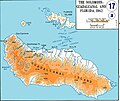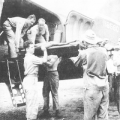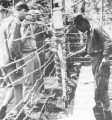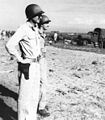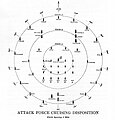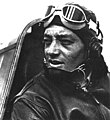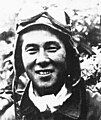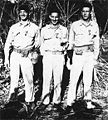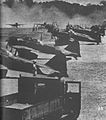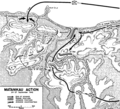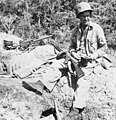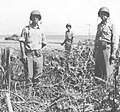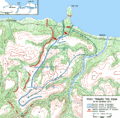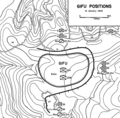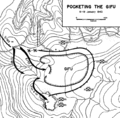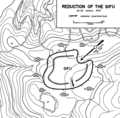Guadalcanal Campaign
Jump to navigation
Jump to search
General Maps
[edit]-
World War II Pacific theater in August, 1942.
-
Pacific Ocean divided up into WWII Allied commands.
-
South Pacific, 1942.
-
Map of southwest Pacific area in 1942-1943.
-
Strategic situation in South Pacific, summer 1942. Red circles are Japanese bases. Blue arrows are Allied shipping and communication lines between U.S. and Australia and New Zealand.
-
Allied lines of communication in the South Pacific, 1942.
-
Solomon and Santa Cruz Islands and New Caledonia area, 1942.
-
Map of the Solomon and Santa Cruz Islands.
-
Guadalcanal
-
Naval battles around Guadalcanal 1942.
-
Wrecks in the Ironbottom Sound
-
Map of the Solomons area showing the major Japanese bases and Henderson Field.
General photos
[edit]-
Supplies are unloaded manually from boats on Guadalcanal sometime between August, 1942, and February, 1943.
-
Injured U.S. Marines are evacuated from Guadalcanal by aircraft sometime between August and December, 1942.
-
Captain Martin Clemens, Australian Coastwatcher on Guadalcanal rendered invaluable services to the Marines. These natives were all members of the Solomon Islands police force.
-
Australian Major J.W. Mather pays wages to a local laborer on Guadalcanal sometime during the battle August - February, 1942.
-
Japanese, Type 93, "Long Lance" torpedo, on display outside U.S. Navy headquarters in Washington, DC, during World War II. This torpedo was recovered from Point Cruz on Guadalcanal.
-
Captured Japanese 150mm artillery gun on Guadalcanal.
-
Japanese prisoners of war on Guadalcanal, 1942-1943.
-
A Japanese POW is interrogated by U.S. Marine intelligence personnel on Guadalcanal.
-
A Marine machine gunner and his Browning .30-caliber M1917 heavy machine gun stand guard while 1st Marine Division engineers clean up in the Lunga River, Guadalcanal sometime between August, 1942 and January, 1943.
-
A M1918 155mm howitzer is fired by artillery crewmen of the 11th Marines in support of ground forces attacking the enemy on Guadalcanal.
-
Flooded U.S. Marine camp near Henderson Field.
-
Japanese soldier demonstrates use of the Model 89 (1929) 50mm Heavy Grenade Discharger. Often called a "knee mortar" by U.S. troops, they were used extensively in Pacific battles by Japanese forces, including on Guadalcanal.
-
U.S. Marines rest in the field on Guadalcanal, sometime between August and December, 1942.
-
Remains of Japanese destroyer Kikutsuki, destroyed by U.S. carrier aircraft on May 4, 1942 on Tulagi island photographed in August, 1943.
-
A Japanese 75mm field gun captured by U.S. forces on Guadalcanal in 1942.
-
A U.S. Marine M3A1 Stuart tank on Guadalcanal in 1942.
-
Captured Japanese 3-inch naval gun, Guadalcanal.
-
U.S. Marines on patrol on Guadalcanal in August, 1942.
-
Japanese machine gun crew on Guadalcanal, probably training before the Allied landings.
-
A U.S. Marine patrol descends from "Edson's" Ridge, Guadalcanal, sometime in 1942. Henderson Field is in the background.
-
A U.S. Marine patrol crosses the Lunga River on Guadalcanal, probably in late September or early October, 1942.
-
U.S. Marines suffering from malaria in a rough field hospital on Guadalcanal, probably in October, 1942.
-
Third from left, LtGen Thomas Holcomb, seventeenth Commandant of the Marine Corps, looks over a captured Japanese despatch-case during his front-line inspection of Guadalcanal in October 1942.
-
U.S. Marines of the 1st Marine Division debark from a transport at Melbourne, Australia after being relieved from duty on Guadalcanal, December, 1942. Note M1903 rifles and sprinkling of "Old Marine Corps" field hats.
-
Supplies are unloaded from landing craft on Guadalcanal sometime during the campaign, August, 1942 - February, 1943.
-
U.S. Marine 105mm gun on Guadalcanal, September, 1942.
-
A U.S. 11th Marines 75mm pack howitzer and crew on Guadalcanal, September or October, 1942.
-
U.S. Marine M3 Stuart tanks operating on Guadalcanal, Aug-November, 1942.
-
Photo of the terrain around Point Cruz on Guadalcanal.
-
A Japanese 70mm field gun captured by U.S. Marines on Guadalcanal.
Commanders
[edit]-
U.S. Marine General Alexander A. Vandegrift.
-
Lieutenant General Harukichi Hyakutake in front of HQ at Rabaul.
-
Japanese Maj Gen Maruyama commanded the Japanese 2nd Infantry Division on Guadalcanal.
-
Japanese Major General Goro Mano who served in the Guadalcanal and New Guinea campaigns.
-
Japanese Colonel Toshinari Shoji commanded the 230th Infantry Regiment on Guadalcanal
-
Japanese Admiral Gunichi Mikawa, victor at Savo Island and participant in several other naval actions around Guadalcanal during the campaign.
-
Japanese Rear Admiral Raizo Tanaka, main leader of the Tokyo Express operations and victor in the Battle of Tassafaronga.
-
Japanese Admiral Nishio Tsukahara commanded the 11th Air Fleet at Guadalcanal until the beginning of October, 1942.
-
Japanese Admiral Jinichi Kusaka commanded the 11th Air Fleet from October, 1942 at Rabaul and later all Japanese naval units in the Solomon Islands' area.
-
Japanese Colonel Ichiki, commander of the battalion defeated in the Battle of the Tenaru River on August 21, 1942. He committed suicide shortly after the battle ended.
-
KAWAGUCHI BRIGADE HEADQUARTERS landed near Tasimboko from destroyers on 6 September. Forty-eight hours later, its base was attacked and destroyed by the 1st Raider Battalion. This picture, with mustachio-ed Major General Kawaguchi in center, was probably taken in Palau.
-
Colonel Mike Edson conducts a staff meeting with his 5th Marine Regimental staff sometime in September or October, 1942.
-
U.S. Marine Col MERRITT A. EDSON, whose defense of the Ridge on Guadalcanal on Sept 13, 1942, saved Henderson Field, was subsequently awarded the U.S. Medal of Honor for his heroism and skill.
-
MAJGEN ROY S. GEIGER, veteran Marine aviation commander, established 1st Marine Air Wing Headquarters on Guadalcanal on 3 September. His mixed, all-Service command soon became known as "Cactus Air Force", because of the code-name for the island.
-
U.S. Americal Division commander, MajGen Alexander M. Patch, Jr., watches while his troops and supplies are staged on Guadalcanal's beaches on 8 December, the day before he relieved Gen Vandegrift.
-
Change of command on Guadalcanal, December 1942. Maj. Gen. Alexander M. Patch, center, succeeds Maj. Gen. Alexander A. Vandegrift (USMC), right. Col. R. Hall Jeschke (USMS) briefs them.
-
U.S. Marine Brigadier General Samuel B. Griffith II, who, as a Lieutenant Colonel, served as executive officer under Merritt Edson in the 1st Raiders and then commanded the battalion.
-
U.S. Marine Lieutenant Colonel "Chesty" Puller photographed on Sep 1, 1942 on Guadalcanal, led a battalion of the 7th Marines.
-
Lieutenant Colonel, later Colonel, Bill Whaling (lower left looking at map) photographed on Guadalcanal in August or September, 1942. Waling led the Whaling Group of scouts and snipers during the Guadalcanal campaign.
Prelude
[edit]-
Organization of Allied South Pacific Forces at the inception of Task 1 (invasion of Guadalcanal), 1942.
-
Organization of Allied Forces for Task One, invasion of Guadalcanal, August, 1942.
-
Allied Task Organization and Command Structure, Guadalcanal-Tulagi Assaults, August 1942.
-
Equipment for the U.S. 1st Marine Division's invasion of Guadalcanal, including amphibious tractors, is prepared in New Zealand prior to the operation.
-
U.S. Marine raiders and the crew of the submarine Argonaut line the deck of the vessel as it returns to Pearl Harbor after the Makin Island raid on August 16, 1942. The raid was supposed to divert Japanese attention from the Guadalcanal operation.
-
The airfield at Lunga Point on Guadalcanal, later called Henderson Field by the Allies, seen under construction by the Japanese in July, 1942.
-
ENROUTE TO Guadalcanal, August, 1942, 105mm howitzers of the 5th Battalion, 11th Marines are lashed on deck of their transport ship.
-
U.S. Marines enter a landing boat during rehearsals on July 26, 1942 in the Fiji Islands for the Guadalcanal operation that were to take place on August 7, 1942.
-
Enroute to Guadalcanal, RAdm Richmond Kelly Turner, commander of the Amphibious Force, and MajGen Alexander A. Vandegrift, 1st Marine Division commander, review the Operation Watchtower plan for landings in the Solomon Islands.
-
MajGen Alexander A. Vandegrift, CG, 1st Marine Division, confers with his staff on board the transport USS McCawley (APA-4) enroute to Guadalcanal.
Landings-Approach, August, 1942
[edit]-
Organization of Allied Landing Force for Task One, invasion of Guadalcanal, August, 1942.
-
Guadalcanal on August 7, 1942.
-
Routes of landing and carrier forces to Guadalcanal and back for August 7, 1942 landings.
-
Routes of Allied landing forces to Tulagi and Guadalcanal islands, August 7, 1942.
-
Cruising disposition of Allied warships and transports for the landingson Guadalcanal and Tulagi, August 7, 1942.
-
Routes and targets of Allied landing forces, August 7, 1942.
-
Route of Allied landing forces invading landing on Guadalcanal and Tulagi, August 7, 1942.
-
Approach and routes of Allied Task Forces 61 & 62 to Guadalcanal, August, 1942.
-
Guadalcanal-Tulagi Objective Area for Allied landings, August 7, 1942.
-
An SBD carrying a bomb takes-off from Enterprise on August 7, 1942 to support Allied forces landing on Guadalcanal and Tulagi Islands.
Battle for Tanambogo and Gavutu, August 7-8, 1942
[edit]-
Map of U.S. Marine landings on Gavutu and Tanambogo.
-
Tanambogo Island after Allied bombardment during the landings on August 7, 1942.
-
Tanambogo after Allied bombardment, August 7, 1942.
-
Tanambogo and Gavutu Islands during or shortly after the battle to take them on August 7, 1942.
-
Battle of Gavutu and Tanambogo, near Tulagi, between U.S. and Japanese forces August 7, 1942.
Battle for Tulagi and Florida Islands, August 7-8, 1942
[edit]-
U.S. Marine landings on Tulagi and Gavutu.
-
Allied landings on Tulagi and nearby islands, August 7, 1942.
-
Map of landings on Tulagi and surrounding islands, August 7, 1942.
-
Allied forces land on Florida Island, August 7, 1942.
-
Tulagi is bombed by U.S. carrier aircraft prior to the U.S. Marine landings on Aug 7, 1942.
-
Allied forces wade ashore at "Beach Blue" on Tulagi, August 7, 1942.
-
Aerial view of southeast end of Tulagi, showing prison, August 7, 1942.
-
Aerial view of Tulagi and surrounding islands, August 7, 1942.
-
Tulagi Island, Solomon Islands annotated vertical aerial photograph, prepared for planning purposes shortly before the island was captured by U.S. Marines on 7-8 August 1942.
-
Officers and petty officers of the 3d Kure Special Naval Landing Force which seized Tulagi and Gavutu in May 1942. The majority of these Japanese subsequently died defending their capture against U.S. Marines.
-
Brigadier General William H. Rupertus, USMC, (center) on board USS Neville (AP-16) during the landings on Tulagi, circa 7-8 August 1942.
-
Dock facilities on Tulagi after Allied bombardment, August 7, 1942.
-
Smoke rises from Tulagi after bombing by U.S. carrier aircraft on 7 August 1942, the day U.S. Marines landed to capture the island. The destroyer at left is either USS Ellet (DD-398) or USS Wilson (DD-408).
-
U.S. ADVANCE ALONG TULAGI was executed during the morning of 7 August by Col Edson's 1st Raider Battalion as shown in this overprinted photograph. Phase Line A was in Marine hands by 1120.
-
U.S. FINAL ASSAULTS ON TULAGI's remaining Japanese positions were delivered August 7 & 8, 1942, by elements of 1st Raider Battalion and 2d Battalion, 5th Marines, as shown on overprint.
-
Allied transports off Tulagi, August 7, 1942.
-
Transports and destroyers off Tulagi during the landings there, circa 7-8 August 1942. Photographed from USS Chicago (CA-29).
-
HMAS Canberra underway off Tulagi, during the landings there, 7-8 August 1942. Three transports are among the ships visible in the distance, with Tulagi and Florida Islands beyond.
-
Japanese and Korean POWs captured during the battle.
-
Marine Officers on Tulagi. (click on image for full details).
Landings on Guadalcanal, August 7-8, 1942
[edit]-
Disposition of Allied transports off Beach Red, Guadalcanal, 7 August 1942.
-
Initial dispostions after landing, Aug 7.
-
Allied landings on Guadalacanal, August 7-8, 1942.
-
Landing on Guadalcanal and Capture of the Airfield: 7-8 August 1942.
-
First Division Marines storm ashore across Guadalcanal's beaches on D-Day, 7 August 1942.
-
Amphibious shipping and landing craft off the Guadalcanal invasion beaches on the first day of landings there, 7 August 1942.
-
U.S. Marine Corps LVT(1) amphibian tractors move toward the beach on Guadalcanal Island. This view was probably taken during the 7-9 August 1942 initial landings on Guadalcanal. Ship in the background is USS President Hayes (AP-39).
-
Allied forces landing on Beach Red, Guadalcanal, August 7, 1942.
-
Supplies are unloaded during the initial landing operations on Guadalcanal, Aug 7-9, 1942.
-
Immediately after assault troops cleared the beachhead and moved inland, supplies and equipment, inviting targets for enemy bombers, began to litter the beach. Guadalcanal, August 7, 1942.
-
Aerial view of Henderson Field on Guadalcanal, August 7, 1942.
-
A US Marine Corps M2A4 "Stuart" light tank is hoisted from Alchiba (AK-23) into a LCM(2) landing craft, off the Guadalcanal invasion beaches on the first day of landings there, 7 August 1942.
-
Japanese "Betty" bombers attack Allied transport ships with torpedoes off Guadalcanal on August 8, 1942.
-
A Japanese aircraft burns on the water after it was shot down by anti-aircraft fire during an attack on U.S. transports between Guadalcanal and Tulagi, 7-8 August 1942. Guadalcanal is in the background, with the heights above Cape Esperance at the right.
-
U.S. destroyer maneuvers off Guadalcanal during Japanese air attack, August 8, 1942.
-
U.S. transport ship George S. Elliott burns after being hit by a Japanese aircraft off Guadalcanal, August 8, 1942.
-
USS George F. Elliott (AP-13) burning between Guadalcanal and Tulagi, after she was hit by a crashing Japanese aircraft during an air attack on 8 August 1942.
-
Largely intact floating wreckage of a Japanese Navy Type 1 land attack plane (a type later code named "Betty"), which crashed during the aerial torpedo attack on the Allied invasion force off Tulagi Island on 8 August 1942. Photographed from USS Ellet (DD-398)
-
U.S. Marines on Guadalcanal, including General Vandegrift (front row, fourth from left) in August, 1942.
-
Initial U.S. Marine defenses at Lunga Point, Guadalcanal, Aug 12, 1942.
-
Native Solomon Islanders, under the direction of Martin Clemens, guide U.S. Marines on a patrol along the Tenaru River on Guadalcanal, August, 1942.
-
Bridge built by U.S. Marine engineers over the Tenaru River to move supplies from the beaches to the Lunga Perimeter on Guadalcanal, August, 1942.
Battle of the Tenaru
[edit]-
Map of U.S. Marine movements and action around Matanikau area, Guadalcanal, August 19, 1942.
-
SGTMAJ VOUSA, British Solomon Islands Constabulary, as he first appeared to U.S. Marines on Guadalcanal, August, 1942. Vouza was captured by the Japanese, tortured and repeatedly bayonetted, but refused to divulge information. Despite serious wounds he escaped, and survived not only to conduct many patrols but to receive U.S. and British decorations.
-
Allied Lunga perimeter and Battle of the Tenaru River, Guadalcanal, August 21, 1942.
-
Map of Battle of Tenaru River (Ilu action), Guadalcanal, August 21, 1942.
-
Japanese Colonel Ichiki, commander of the battalion defeated in the Battle of the Tenaru River on August 21, 1942.
-
Bodies of Japanese soldiers of Ichiki's battalion killed during the Battle of Tenaru River, August 21, 1942.
-
Dead Japanese soldiers lie on the sandbar at the mouth of Alligator Creek on Guadalcanal on August 21, 1942.
Cactus Air Force and Henderson Field
[edit]-
Henderson Field on Guadalcanal as it looked on August 7, 1942.
-
90MM ANTIAIRCRAFT GUNS of the 3d Defense Battalion point skyward at Henderson Field on alert against the attacks of Japanese bombers.
-
U.S. Marine Major John L. Smith, photographed after his return to the U.S., received a Medal of Honor for his actions and service at Henderson Field during the Battle for Guadalcanal.
-
U.S. Marine CAPT J. J. FOSS, of VMF-121, received the Medal of Honor for outstanding heroism as a fighter pilot during the Guadalcanal campaign flying out of Henderson Field.
-
Cactus Air Force commander, MajGen Roy S. Geiger, poses with Capt Joseph J. Foss, the leading ace at Guadalcanal with 26 Japanese aircraft downed.
-
Watercolor depicting a dogfight between a U.S. Marine Wildcat and a Japanese Zero over Henderson Field on Guadalcanal.
-
Wreckage of a SBD scout-bomber, still burning after it was destroyed by a Japanese air attack on Henderson Field, Guadalcanal, 1942.
-
Enlisted pilots of the Tainan Kokutai pose at Rabaul in 1942. Several of these aviators would be among the top Japanese aces, including Saburo Sakai (middle row, second from left), and Hiroyoshi Nishizawa (standing, first on left). These pilots fought with Allied fighter pilots during the Battle of Guadalcanal and the Solomon Islands campaign
-
Lt (j.g.) Junichi Sadai of the Tainan Air Group. This 1942 photo shows the young combat leader, of such men as Sakai and Nishizawa, shortly before his death over Guadalcanal.
-
These A6M3s are from the Taman Air Group based at Rabaul in 1942, and several sources have identified aircraft 106 as being flown by top ace Nishizawa. Typically, these fighters carry a single centerline fuel tank.
-
this view looking south over Point Cruz shows the jumble of sharp-grassed ridges, foothills and mountainous jungle which was Guadalcanal.
-
The first Allied aircraft to land at Henderson Field, a PBY Catalina, touches down on August 12, 1942. It evacuated two wounded U.S. Marines.
-
Picture of the "Pagoda" a former Japanese building used as the air operations center at Henderson Field on Guadalcanal until it was bulldozed in mid-October, 1942.
-
Five U.S. Army P-400s arrived at Henderson Field, the first Army personnel or aircraft to reach Guadalcanal, on 22 August, 1942.
-
A TBF Avenger operating out of Henderson Field, Guadalcanal, probably around August or September, 1942.
-
This MAG-23 F4F-4 Wildcat is being saved by bucket-brigade methods. Note bullet-pierced propeller blades. Aircraft was damaged by during Japanese air attack at Henderson Field, Guadalcanal, probably in August or September, 1942.
-
U.S. Marine F4F Wildcats head-out from Henderson Field, Guadalcanal, probably in August or September, 1942, to intercept incoming Japanese aircraft.
-
MAJGEN ROY S. GEIGER, veteran Marine aviation commander, established 1st Marine Air Wing Headquarters on Guadalcanal on 3 September. His mixed, all-Service command soon became known as "Cactus Air Force", because of the code-name for the island.
-
U.S. Marine "Cactus Air Force" pilots at Henderson Field, mid-September, 1942.
-
Henderson Field on Guadalcanal as it looked in September, 1942.
-
A U.S. TBF Avenger parked at Henderson Field, Guadalcanal, probably in late September or October, 1942.
-
Watercolor of U.S. Marine aircraft operating at Henderson Field in October, 1942.
-
Watercolor of Capt Joe Foss as he shoots down a Japanese Zero over Henderson Field on Guadalcanal in October 1942.
-
Watercolor of U.S. Marine Captain Joe Foss shooting down a Zero over Guadalcanal in October, 1942.
-
Henderson Field on Guadalcanal is bombed during the October 24-25, 1942 Japanese offensive.
-
Anti-aircraft gun and crew of the U.S. Marine 3d Defense Battalion helping defend Henderson Field from Japanese air attack on Guadalcanal in October, 1942.
-
MAJ R.E. GALER received the Medal of Honor for conspicuous heroism both as fighter pilot and commanding officer of VMF-224 at Henderson Field on Guadalcanal.
-
Cactus Air Force aircraft crowd Henderson Field, Guadalcanal in October, 1942.
-
Three CAF pilots after receiving the Navy Cross from Admiral Nimitz, September 30, 1942.
-
U.S. Army P-400 aircraft "Short Stroke" that operated with the Cactus Air Force.
-
1stLt Stanley S. Nicolay beside a Wildcat, probably just before deploying to the Pacific in 1942.
-
USMC Lt Col Bauer on Guadalcanal sometime before his death in combat.
-
Japanese A6M3 Zero "Hamp" at either Buka or Buin airfield during the Guadalcanal campaign.
-
Japanese A6M2-N float Zero fighter.
-
Japanese G4M "Betty" bombers, perhaps during the Guadalcanal campaign.
-
Smith, Mangrum, and Carl after returning to the U.S.
-
USMC Brigadier General Geiger with staff members on Guadalcanal, 1942.
-
Wildcat with aircraft captain at Henderson Field.
-
Front view of the "Pagoda" at Henderson Field on Guadalcanal before it was bulldozed in October, 1942.
-
A U.S. F4F Wildcat at Henderson Field on Guadalcanal, August, 1942.
-
Aerial view of the "Pagoda" area of Henderson Field, probably in September, 1942.
-
USMC Captain Jefferson J. DeBlanc, awarded the Medal of Honor for his actions with the Cactus Air Force on Guadalcanal in 1942.
-
A Japanese aircraft falls in flames over Guadalcanal after being shot-down by a Cactus Air Force fighter sometime in 1942.
-
Marine TBF Avenger crew of MAG-23 prepare to board their aircraft at Henderson Field.
-
Cactus Air Force pilots hold a standing meeting around the "duty board" at Henderson Field.
-
Japanese aircraft prepare to launch on a mission from an airfield at Rabaul, New Britain, sometime between August and November, 1942.
Tokyo Express
[edit]-
Japanese Rear Admiral Raizo Tanaka, main leader of the Tokyo Express operations and victor in the Battle of Tassafaronga.
-
Japanese troops load onto a destroyer in preparation for a "Rat Transportation" (called "Tokyo Express" by Allied forces) to Guadalcanal in 1942.
-
A Japanese transport destroyed by aircraft from Henderson Field at Tassafaronga, Guadalcanal on October 14, 1942.
Battle of Edson's Ridge
[edit]-
Map of U.S. Marine Tasimboko raid, September 8, 1942, on Guadalcanal.
-
U.S. Marine Lunga Perimeter, Guadalcanal, September 12-14, 1942.
-
KAWAGUCHI BRIGADE HEADQUARTERS landed near Tasimboko from destroyers on 6 September. Forty-eight hours later, its base was attacked and destroyed by the 1st Raider Battalion. This picture, with mustachio-ed Major General Kawaguchi in center, was probably taken in Palau.
-
Japanese troops from the "Aoba" Regiment march along the shore of Guadalcanal shortly after landing in the first week of September, 1942.
-
Battle of Edson's Ridge, Guadalcanal, first phase, 12-13 September, 1942.
-
Battle of Edson's Ridge, Guadalcanal, first phase, 12-13 September, 1942.
-
Battle of Edson's Ridge, Guadalcanal, first phase, 12-13 September, 1942.
-
Battle of Edson's Ridge, Guadalcanal, final phase, night of August 13-14, 1942.
-
Battle of Edson's Ridge, Guadalcanal, final phase, night of August 13-14, 1942.
-
Battle of Edson's Ridge, Guadalcanal, final phase, night of August 13-14, 1942.
-
Map of Lunga Perimiter and Battle of Edson's Ridge, Guadalcanal, Sept, 1942.
-
Battle of "Bloody Ridge" on Guadalcanal, September 12-14, 1942.
-
Japanese attack on Edson's Ridge, September 13, 1942.
-
Edson's (Bloody) Ridge: 12-14 September 1942, Guadalcanal.
-
A U.S. Marine guards Hill 80 on "Edson's" Ridge, Guadalcanal in 1942. The view is towards the south from whence the Japanese attacked during the battle in September, 1942.
-
A U.S. Marine looks at some fighting positions on Edson's Ridge (probably on Hill 123, looking north), September, 1942.
-
View of final line positions on Edson's Ridge, Guadalcanal that barely held during the battle on Sept 13, 1942 as viewed from Bailey's intermediate position just southward.
-
View of grassy plain from U.S. Marine positions near Edson's Ridge across which the Japanese 1st Battalion, 124th Infantry delivered an attack during the battle on Sept 13, 1942, on Guadalcanal.
-
The raging battle of Edson's Ridge is depicted in all its fury in this oil painting by the late Col Donald L. Dickson, who, as a captain, was adjutant of the 5th Marines on Guadalcanal.
-
Dead Japanese soldiers lie near Hill 123 on the ridge after the battle on September 15.
-
U.S. Marine Col MERRITT A. EDSON, whose defense of the Ridge on Guadalcanal on Sept 13, 1942, saved Henderson Field, was subsequently awarded the U.S. Medal of Honor for his heroism and skill.
-
U.S. Marine MAJ KENNETH D. BAILEY, wounded during the Battle of Edson's Ridge on Guadalcanal, subsequently killed in action on the Matanikau, was posthumously awarded the Medal of Honor for his fight on the Ridge.
Action along the Matanikau (September 1942)
[edit]-
Wasp burning after begin torpedoed by a Japanese submarine south of Guadalcanal, September 15, 1942.
-
U.S. positions in the Lunga Perimeter on Guadalcanal following the Battle of Edson's Ridge, late September, 1942.
-
Action along the Matanikau, Guadalcanal, September, 1942.
-
Map of Matanikau action between U.S. Marines and Japanese forces, September 24-27, 1942, on Guadalcanal.
-
Aerial map of Point Cruz, Guadalcanal overlaid with actions by U.S. and Japanese forces during operations in late September, 1942.
-
The 1st Battalion, 7th Marines, withdraws from its dangerously exposed position west of Point Cruz, Guadalcanal, under cover of naval gunfire and artillery support in late September, 1942.
-
U.S. and Japanese actions along the Matanikau River, Guadalcanal, 23-27 Sep, 1942.
-
U.S. Marines evacuate under fire near Point Cruz on September 27.
-
A U.S. Marine patrol crosses the Lunga River on Guadalcanal, probably in late September or early October, 1942.
October Action Along the Matanikau
[edit]-
U.S. Matanikau offensive on Guadalcanal, October 7-9, 1942.
-
U.S. Matanikau offensive on Guadalcanal, October 7-9, 1942.
-
ACTION ON THE MATANIKAU, Guadalcanal, from 7 to 9 October, 1942, enabled General Vandegrift to establish forward positions in that area during the balance of the campaign.
-
U.S. positions along the Matanikau and Lunga Point, October 9, 1942.
-
U.S. Marine defensive positions along the Matanikau River, Guadalcanal, October, 1942.
-
The 1st Raider Battalion and the 2d Battalion, 5th Marines, found themselves immobilized by the Japanese along the Matanikau River on Guadalcanal in October, 1942.
-
Dead soldiers from the Japanese 2nd Battalion, 4th Infantry Regiment lie piled in a ravine on Guadalcanal after being killed by mortar and small arms fire from United States Marine Corps troops of the 1st Battalion, 7th Marines under Chesty Puller on October 9, 1942
Battle for Henderson Field
[edit]-
A Japanese transport destroyed by aircraft from Henderson Field at Tassafaronga, Guadalcanal on October 14, 1942.
-
Japanese attacks on U.S. forces, October 23-25, 1942.
-
Japanese attacks on U.S. forces, October 23-25, 1942.
-
Japanese attacks on the U.S. perimeter on Guadalcanal, Oct 23-25, 1942.
-
Conoley's Action, 24-26 October 1942, near the Matanikau River, Guadalcanal.
-
Japanese Lt Gen Hyakutake, here photographed at his headquarters on Rabaul, commanded Japanese forces during the late October, 1942 offensive on Guadalcanal.
-
Japanese Maj Gen Maruyama commanded Japanese forces on Guadalcanal.
-
Wreckage of the Japanese 1st Independent Tank Company on the sandbar at the mouth of the Matanikau River on Guadalcanal after the failed October offensive to take Henderson Field.
-
During the lull in the Battle for Henderson Field, a Marine machine gunner takes a break for coffee, with his sub-machine gun on his knee and his .30-caliber light machine gun in position.
-
U.S. Marine 150mm howizter fires at Japanese forces on Guadalcanal west of the Matanikau River in late October, 1942.
-
U.S. Marine Sgt John Basilone was awarded the Medal of Honor for his actions during the late October, 1942 battles on Guadalcanal.
-
SGT MITCHELL PAIGE receives the Medal of Honor from Gen Vandegrift as a reward for outstanding heroism while manning a machine-gun of the 2d Battalion, 7th Marines during the late October, 1942 battles for Henderson Field on Guadalcanal.
-
Henderson Field on Guadalcanal is bombed during the October 24-25, 1942 Japanese offensive.
-
Anti-aircraft gun and crew of the U.S. Marine 3d Defense Battalion helping defend Henderson Field from Japanese air attack on Guadalcanal in October, 1942.
-
Third from left, LtGen Thomas Holcomb, seventeenth Commandant of the Marine Corps, looks over a captured Japanese despatch-case during his front-line inspection of Guadalcanal in October 1942.
-
Dead Japanese soldiers from the 2nd Infantry division lie in front of the Lunga defenses after failed assaults during the battle.
-
Colonel Clifton Cates (right) commander of the 1st Marine Regiment and Colonel Mike Edson (center, third from right), commander of the 5th Marine Regiment, inspect the battlefield at the mouth of the Matanikau River on Guadalcanal after the Battle for Henderson Field in late October, 1942
November action on and beyond the Matanikau
[edit]-
U.S. forces push towards Point Cruz and Kokumbona on Guadalcanal, November 1-4, 1942.
-
U.S. forces push towards Point Cruz and Kokumbona on Guadalcanal, November 1-4, 1942.
-
U.S. operations in the Point Cruz area, Guadalcanal, early November, 1942.
-
Area around Point Cruz.
-
U.S. 5th Marines evacuate injured personnel during actions on Guadalcanal on November 1, 1942.
-
A U.S. destroyer provides gunfire support for U.S. forces on Guadalcanal during actions in early November, 1942.
-
U.S. Marines cross the Matanikau on a raft ferry in November, 1942.
-
Two U.S. Marines check a Japanese coral block bunker near Point Cruz in November, 1942.
-
Japanese log and earth bunker near Point Cruz in November, 1942.
-
U.S. Marines drag dead Japanese soldiers from their bunker near Point Cruz in November, 1942.
-
U.S. advance towards Poha river, November 18-20, 1942.
Aola Bay, Koli Point and Carlson's "Long Patrol"
[edit]-
U.S. forces offensive at Koli Point, Guadalcanal, November, 1942.
-
Action at Koli Point between U.S. and Japanese forces on Guadalcanal, November 2-3, 1942.
-
U.S. movement and action at Koli Point, November 4-9, 1942.
-
75 mm pack howitzers of the 1st Battalion, 11th U.S. Marine Regiment fire in support of the U.S. Marine and Army operation against Japanese forces around Koli Point on Guadalcanal in November, 1942.
-
Marine artillery forward observer in a tree near Koli Point.
-
A U.S. destroyer provides gunfire support for U.S. forces on Guadalcanal during actions in early November, 1942.
-
Marines use a field telephone during the Koli Point action.
-
Marine wounded are evacuated from Koli Point during the action.
-
Carlson's Raiders land at Aola Bay.
-
Native guides lead 2d Raider Battalion Marines during the "Long Patrol" combat/reconnaissance patrol behind Japanese lines, November, 1942.
-
Major James Roosevelt, son of U.S. President Franklin Roosevelt, was the executive officer of the 2nd Raiders on the Makin Raid and Guadalcanal.
-
Map of Carlson's "Long Patrol."
Final phase-general pictures
[edit]-
An SBD over Enterprise (foreground) and Saratoga (background) near Guadalcanal in December 19, 1942.
-
Members of the U.S. Army Americal division lands on Guadalcanal in December, 1942.
-
U.S. Army Americal Division 37mm guns are unloaded on Guadalcanal, December, 1942.
-
U.S. Marines depart Guadalcanal in December, 1942.
-
U.S. Americal Division commander, MajGen Alexander M. Patch, Jr., watches while his troops and supplies are staged on Guadalcanal's beaches on 8 December, the day before he relieved Gen Vandegrift.
-
Change of command on Guadalcanal, December 1942. Maj. Gen. Alexander M. Patch, center, succeeds Maj. Gen. Alexander A. Vandegrift (USMC), right. Col. R. Hall Jeschke (USMS) briefs them.
-
Battle area on Guadalcanal, December, 1942 through January, 1943.
-
Battle area on Guadalcanal, December, 1942 through January, 1943.
-
Last phase of Battle of Guadalcanal, Jan-Feb, 1943.
Galloping Horse and western offensives
[edit]-
U.S. positions along the Matanikau in early December, 1942.
-
U.S. forces planned assault from Matanikau River area on Guadalcanal, January, 1943.
-
Aerial photo of the "Galloping Horse" Japanese stronghold on Guadalcanal, late 1942 or early 1943.
-
U.S. Army western offensive, Guadalcanal, January, 1943.
-
U.S. forces attack "Galloping Horse" during drive from Matanikau, January 10, 1943.
-
U.S. forces attack Japanese positions on "Galloping Horse" on Guadalcanal during the drive from the Matanikau, January 12-13, 1943.
-
U.S. forces push forward from Matanikau, January 12-16, 1943.
-
U.S. forces advance from Matanikau River, Guadalcanal, January 13-18, 1943.
-
U.S. forces advance in Matanikau River area, Guadalcanal, January 10-18, 1943.
-
U.S. forces actions on Guadalcanal west of the Matanikau, January 22, 1943.
-
U.S. forces capture Kokumbona on Guadalcanal, January 23-25, 1943.
-
U.S. forces capture Kokumbona on Guadalcanal, January 23-25, 1943.
-
A wounded soldier is being assisted down a steep jungle hillside, then through the jungle to the river and by boat and ambulance to a nearby hospital. Guadalcanal, 1/15/43. Soldier of 25th Division, 35th Infantry. Matanikau River.
-
U.S. Army soldiers push supplies up the Matanikau River to support the 25th Infantry Division's offensive on Guadalcanal in January, 1943.
-
A wounded 35th Infantry Regiment soldier is evacuated from the front on 15 January.
Gifu offensive
[edit]-
U.S. forces move on Gifu pocket and Mt. Austen on Guadalcanal, December 18-27, 1942.
-
U.S. forces capture Hill 27 during assault on Gifu pocket on Guadalcanal, January 2, 1943.
-
U.S. forces assault Japanese positions on "Seahorse", Guadalcanal, January 8-11, 1943.
-
U.S. and Japanese positions, Gifu pocket, Guadalcanal, January 10, 1943.
-
U.S. forces surround and assault Japanese forces in the Gifu pocket, Guadalcanal, January 18-19, 1943.
-
U.S. attacks on Japanese forces in the Gifu pocket, Guadalcanal, January 22-23, 1943.
-
A Japanese defensive position after the battle of the Gifu pocket on Guadalcanal, January, 1943. The position consists of a bunker with a covered foxhole in front of it.
Final push and Japanese Ke evacuation
[edit]-
Final actions in Battle of Guadalcanal, Jan 26-Feb 9, 1943.
-
Litter bearers give first aid to two men wounded by grenades while on patrol on Guadalcanal. Even when under direct fire of the enemy the bearers continue to care for and carry out the wounded. They are commanded by Major General Alexander M. Patch, Jr. 25th Medical BN., 25th Division. 10 January 1945
-
A dead Japanese soldier on Guadalcanal, photographed January 25, 1943.
-
The crew of U.S. PT boat PT 65 inspects the wreckage of Japanese submarine I-1 at Kamimbo on Guadalcanal, February, 1943.
Aftermath
[edit]-
U.S. Marines of the 1st Marine Division debark from a transport at Melbourne, Australia after being relieved from duty on Guadalcanal, December, 1942. Note M1903 rifles and sprinkling of "Old Marine Corps" field hats.
-
The temporary resting place of a U.S. Marine killed in the fighting at Lunga Point on Guadalcanal is shown here. The grave marker was probably erected by his friends. The Marine's remains were later removed to the division cemetery on Guadalcanal, and further reburial at war's end either in his hometown or the Punchbowl National Cemetery in Hawaii.
-
The Russell Islands.
-
The High Command assembled on Guadalcanal in 1943, during the planning for the Northern Solomons campaign, this group includes many officers who played important roles in the operations to come. In the front row, left to right, are: Brigadier General A. F. Howard, Rear Admiral Theodore Wilkinson, USN, Major General Charles D..Barrett, and Major General Robert S. Beightler, USA.
-
Guadalcanal, Solomons Islands. Coastwatcher personnel at their headquarters in front of the wireless hut after Guadalcanal was secured in 1943.
-
Lunga, Guadalcanal, Solomon Islands. 1943-10. The base radio station dugout of the Coastwatchers Ken network in the Solomon Islands.
-
President Franklin D. Roosevelt presents Gen Vandegrift the Medal of Honor for his heroic accomplishments against the Japanese in the Solomons.
-
Wrecks of Japanese ship Yamazuki Maru and midget submarine on beach at Guadalcanal. Photographed in 1944.
-
Henderson Field in August, 1944.
-
Cemetery on Guadalcanal for both Allied and Japanese remains. Photographed in 1945.
-
In a White House ceremony, former Cpl Anthony Casamento, a machine gun squad leader in the 1st Battalion, 5th Marines, was decorated by President Jimmy Carter on 22 August 1980, 38 years after the battle for Guadalcanal.








